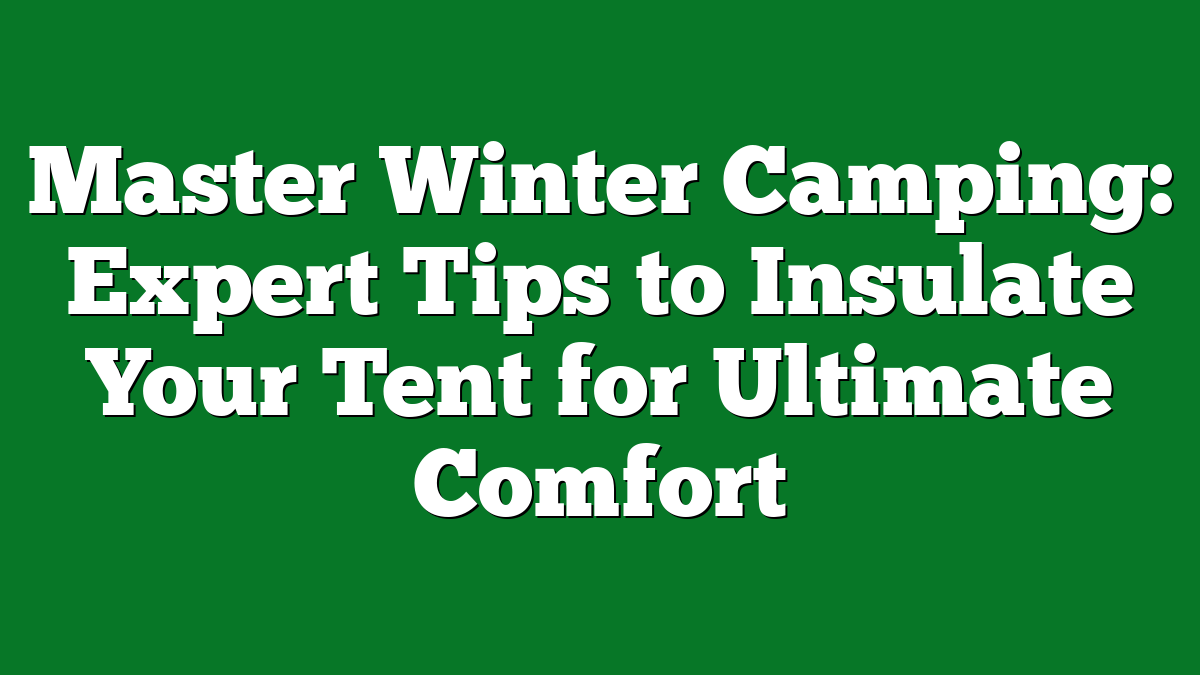Winter camping can feel like a magical adventure, but it comes with its own set of challenges. As the temperatures drop and snow blankets the ground, staying warm and cozy in your tent becomes a top priority. I’ve learned that proper insulation is key to turning a chilly night into a comfortable experience under the stars.
Winter Camping: How to Insulate a Tent
Insulating a tent for winter camping is crucial for comfort and safety. I’ve gathered several methods that work effectively to keep the cold at bay.
Use a Tent with a Rainfly
Using a tent with a rainfly keeps heat inside. This outer layer reduces wind chill and provides extra insulation. Look for a three-season or four-season tent that suits winter conditions.
Insulation Layers
Placing insulating layers on the tent floor helps retain heat. Use foam pads or inflatable sleeping pads for comfort. Adding a space blanket or reflective mylar underneath enhances warmth by reflecting body heat.
Add Extra Blankets
Bringing extra blankets inside the tent serves two purposes. They provide warmth and create a cozy atmosphere at night. I recommend using fleece or wool blankets for optimal insulation.
Use a Tent Heater
A tent heater can substantially increase the temperature inside the tent. When using one, ensure proper ventilation to avoid carbon monoxide buildup. I prefer portable, propane-powered heaters for their efficiency.
Clothing and Gear
Choosing the right clothing also plays an important role. Wear layered clothing, use thermal socks, and always have a warm sleeping bag rated for low temperatures. A sleeping bag with synthetic or down insulation works best for extreme cold.
Ground Insulation
Insulating the ground beneath the tent prevents cold from seeping up. Adding a ground tarp or foam pads increases insulation. Grass, leaves, or snow can add additional layers between your body and the cold ground.
Use of a Tent Carpet
A tent carpet adds an extra insulating layer. It not only improves comfort but also reduces heat loss through the floor. Choose a thermal tent carpet designed for winter use for maximum efficiency.
Keep the Tent Sealed
Keep the tent sealed against drafts. I always check the zippers and seams for any gaps. Using weather stripping can help seal any areas that let cold air in.
Maintenance of Gear
Regularly check and maintain gear to ensure it operates efficiently. Make sure your sleeping bag stays dry and clean, as moisture can significantly reduce its insulation properties.
Implementing these methods makes winter camping enjoyable. Staying warm not only enhances the experience but also allows for a good night’s sleep, ready for adventure the next day.
Importance of Insulation in Winter Camping
Insulation plays a critical role in winter camping. Staying warm transforms a potentially miserable experience into a cozy adventure. Here’s why insulation matters, along with the benefits of doing it right and the consequences of neglecting it.
Benefits of Proper Insulation
- Maintains Body Heat: Proper insulation keeps the warm air from my body trapped inside the tent. This can make a significant difference when temperatures plummet at night.
- Improves Comfort: Insulating my tent creates a more comfortable sleeping environment. Extra layers mean I can rest well, ready for the adventures waiting outside.
- Reduces Condensation: Insulation minimizes condensation build-up. A well-insulated tent stays drier, ensuring my gear doesn’t get soaked by moisture from the cold air.
- Enhances Sleep Quality: Warmth contributes to quality sleep. Insulation allows me to recharge fully, which is vital for tackling long hikes or fishing excursions the next day.
- Increases Versatility: A well-insulated tent allows for winter camping, too. I can enjoy the beauty of snowy landscapes without worrying about freezing temperatures.
Consequences of Inadequate Insulation
- Increased Risk of Hypothermia: Poor insulation exposes me to extreme cold, increasing the risk of hypothermia. Being cold can sap my body’s energy and alertness rapidly.
- Uncomfortable Conditions: Without proper insulation, my nights become restless and uncomfortable. Sleep deprivation impacts my ability to enjoy outdoor activities.
- Gear Damage: Inadequate insulation can lead to moisture build-up, risking damage to camping gear. Electronics and clothing could suffer if they get wet during the night.
- Reduced Enjoyment: The joy of winter camping diminishes without insulation. Feeling cold and uncomfortable can turn a dream trip into a stressful experience.
- Safety Hazards: Lack of warmth can lead to disorientation or impaired judgment. Keeping warm is essential for staying safe, especially when in remote areas.
Having proper insulation is essential, not just for comfort but also for safety and enjoyment during winter camping.
Choosing the Right Tent for Winter Camping
Selecting the right tent is crucial for a successful winter camping experience. A suitable tent provides shelter from the elements and allows for effective insulation to keep you warm.
Features to Look For
- Four-Season Design: Choose a tent designed for winter use, built to handle heavy snow and strong winds.
- Strong Material: Look for tents made from durable, waterproof materials that resist condensation and block drafts.
- Ventilation Options: Ensure the tent has vents to reduce moisture buildup and control air circulation without sacrificing warmth.
- Low Profile: Opt for tents with a reduced height to minimize wind resistance; a lower tent handles blustery conditions better.
- Sturdy Poles: Select tents with reinforced poles, typically made from aluminum, for added strength and stability against snow loads.
Recommended Tent Types
- Mountaineering Tents: Ideal for extreme conditions, these tents offer strong structures and robust materials to handle harsh weather.
- Snow Shelters: These are alternative options created from snow that provide excellent insulation, utilizing natural elements for warmth.
- Canvas Tents: Heavy-duty canvas tents can provide great insulation and warmth when properly pitched and sealed against the cold.
- Tunnel Tents: A good choice for winter camping, these tents offer a spacious interior and maintain effective wind resistance.
Choosing the right tent type equipped with essential features ensures a warm, safe, and enjoyable winter camping experience.
Insulation Methods for Your Tent
Insulating your tent effectively can make a significant difference in your winter camping experience. Here are some key methods to keep the cold at bay while enjoying the great outdoors.
Ground Insulation Techniques
Using proper ground insulation offers a solid barrier against the cold. I recommend placing a tarp or ground cloth beneath your tent to shield against moisture and frost. Next, layering sleeping pads, like foam or inflatable varieties, on the floor boosts insulation significantly. For extra warmth, I often bring along a combination of pads to create a thicker insulating layer. If you want to enhance comfort further, consider adding a tent carpet, which can help trap heat and provide a cozy feel underfoot.
Wall and Ceiling Insulation Options
Insulating the walls and ceiling of your tent helps maintain warmth, especially when temperatures dip. Start by draping extra blankets or insulated liners inside the tent. These materials trap body heat and minimize heat loss. I often use reflective emergency blankets as an economical option; they reflect warmth back into the tent. If your tent has a rainfly, ensure it’s fitted tightly to reduce wind chill. Additionally, employing sleeping bags with good temperature ratings can add another layer of insulation, maximizing warmth throughout the night.
Additional Tips for Staying Warm
Staying warm during winter camping requires attention to detail beyond just insulation. Here are some essential tips to maximize your comfort and warmth.
Clothing and Gear Considerations
Choosing the right clothing and gear is crucial for winter camping. Wear moisture-wicking base layers to keep sweat away from your skin. Add insulating mid-layers like fleece or down jackets for warmth. Opt for waterproof and windproof outer layers to shield against the elements.
Pick boots insulated for cold temperatures, and ensure they’re comfortable for long hikes. Use thick, wool socks and consider bringing extra pairs to keep feet dry and warm. Accessories like hats, gloves, and scarves are vital, as heat escape often occurs from the head and extremities. Don’t forget to bring hand warmers for added comfort.
Managing Your Tent’s Ventilation
Managing your tent’s ventilation keeps condensation at bay while retaining warmth. Open vents slightly to allow moisture to escape without letting in excessive cold air. Fine-tune ventilation based on weather conditions; if it’s dry and windy, keep vents wide, but in still, damp conditions, close them enough to protect warmth while preventing moisture build-up.
Position the tent strategically, with the entrance facing away from prevailing winds. Keep the tent sealed tightly, checking zippers and seams regularly. These airflow adjustments ensure you stay dry and warm, making nights in the great outdoors more enjoyable.
Conclusion
Winter camping can be an incredible adventure if you’re prepared. Insulating your tent is key to staying warm and cozy when temperatures drop. By using the right techniques and gear you can transform your cold nights into comfortable experiences.
I’ve found that a well-insulated tent not only keeps the chill at bay but also enhances my overall enjoyment of the great outdoors. With the right tent and insulation methods I’m ready to embrace the beauty of winter while staying safe and warm. So gather your gear and get ready for a memorable winter camping trip. Happy camping!











